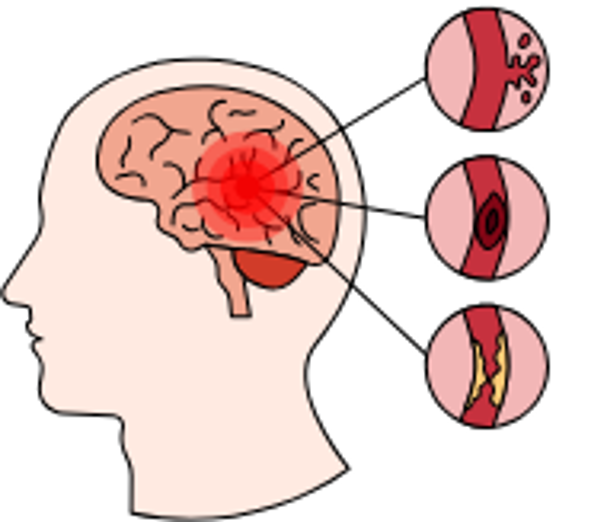Blog | Specialized Care
Stroke: A Synopsis
published: 5/5/2025
viewedby 3149 visitors
Introduction
Stroke is a devastating condition that may cause a profound change in the lives of its patients and their relatives. Understanding the underlying cause, risk factors, symptoms/signs, and necessary preventive measures of stroke, no matter how small the knowledge may be, may help reduce the health, social, and economic burden prompted by this cerebrovascular accident.

1. Epidemiology
From 1990 to 2021, the number of people suffering from stroke, dying from stroke, or living with disability after experiencing stroke has risen profoundly;
•Incidents (new cases) increased by 70%
•Deaths increased by 44%
•Disabilities increased by 32%
In the 2021 Global Burden of Disease study, stroke is estimated to be the second leading cause of death and the third leading cause of death and disability combined. Moreover, every year, there will be:
•+ 12 million new strokes
•+ 7 million deaths due to stroke
•+ 94 million people living with disabilities due to stroke
To put this in the perspective of our daily lives:
•One in 4 people will experience a stroke in their lifetime
•More than half (53%) of strokes occur in those <70 years old
•Almost 90% of the stroke burden is in low-to-middle-income countries
2. Symptoms & Signs
There are a myriad of stroke symptoms and signs. Nevertheless, they all share the same characteristic: they occur suddenly. Some of the more common are as follows:
•One-sided face weakness or droop
•One-sided arm weakness
•Slurred speech
Other symptoms and signs might include:
•Loss of consciousness
•Severe headache
•Nausea or vomiting
•Dizziness or imbalance
•Difficulty understanding spoken or written language
•Body weakness/numbness
•Confusion or forgetfulness
All these symptoms/signs may be reversible in 24 hours (a condition coined ‘transient ischemic attack’), but it may also progressively worsen until it becomes life-threatening.
3. Types
Stroke basically can be categorized as either:
•Ischemic (70-80% of all cases), due to reduction/blockage of the brain’s blood supply
•Hemorrhagic (20-30% of all cases), due to the rupture of cerebral blood vessels

4. Risk factors
Several risk factors might predispose a person to experience a stroke, such as:
•Age: the older a person, the higher the risk
•Race: South Asian or African descendants have a higher risk
•Unhealthy lifestyle: smoking, sedentary behavior, diet high in sodium and low in vegetables/fruit, high alcohol intake
•Other conditions: high blood pressure/hypertension, high cholesterol/hypercholesterolemia, atrial fibrillation, and diabetes
5. Diagnosis
Stroke is diagnosed through careful interview and physical examination by qualified health care professionals specializing in stroke management. The presence of its symptoms and signs might raise the suspicion of a person having a stroke.
These further examinations may need to be commenced to assist health care professionals in correctly diagnosing stroke and deciding the best treatment:
•Laboratory: routine blood examination, lipid profile, kidney function tests
•Electrophysiologic: electrocardiogram
•Radiologic: computed tomography (CT) scan, magnetic resonance imaging (MRI, and digital subtraction angiography (DSA)
6. Management
Treatment will be focused and directed according to the type of stroke. Moreover, several factors, such as the time from stroke onset to receiving treatment, the severity, the primary cause, and the complications of stroke, contribute to the treatment decision.
•Ischemic stroke:
◦ Thrombolysis: drug administration to destroy the clot within the brain’s blood vessel
◦ Thrombectomy: endovascular thrombectomy, a minimally invasive procedure performed through the blood vessels in the groin or radial to remove the clot
◦ Decompressive craniectomy: surgery to remove pressure building from within the skull
•Hemorrhagic stroke:
◦ Endoscopic/craniotomy hematoma evacuation: surgery to remove a blood clot inside the brain that may be performed using open craniotomy or endoscopy instruments
◦ Clipping/coiling: procedure to prevent an aneurysm (ballooning in the wall of a blood vessel) from experiencing re-rupture and re-bleeding
◦ Decompressive craniectomy: as aforementioned
7. Prevention
In 2024, the American Heart Association/American Stroke Association (AHA/ASA) published a guideline for primary stroke prevention. There are 8 components (“Life’s Essential 8”) deemed important to reduce a person’s probability of having a stroke:
•Healthy diet – the Mediterranean diet, sodium substitution
•Physical activity – regular moderate-to-vigorous
•Healthy weight – stay within the recommended body mass index
•Healthy sleep
•Avoidance of tobacco products
•Healthy levels of blood lipids
•Healthy levels of blood glucose, and lastly
•Healthy levels of blood pressure
8. What to do when you experience/witness others experiencing the symptoms/signs of stroke?
Please go directly to the nearest health care facility with the proper resources to manage stroke (neurologists and/or neurosurgeons present, 24-hour catheterization lab and operating theaters). Do not waste time. Each second matters.
9. References
The National Health Service (NHS) UK, Stroke, https://www.nhs.uk/conditions/stroke/symptoms/
2024 Guideline for the Primary Prevention of Stroke: A Guideline From the American Heart Association/American Stroke Association, https://www.ahajournals.org/doi/pdf/10.1161/str.0000000000000475
The World Stroke Organization: Global Stroke Fact Sheet 2025, https://pmc.ncbi.nlm.nih.gov/articles/PMC11786524/
about_author
Dr. Aryandhito Widhi Nugroho, M.D., Ph.D

Neurosurgeon, Bali International Hospital
Dr. Aryandhito Widhi Nugroho, Ph.D., is a highly accomplished neurosurgeon with a robust academic and clinical background. He earned his Neurosurgery degree from Universitas Indonesia in 2020, complemented by a Doctor of Philosophy (Ph.D.) from Shiga University of Medical Science in Japan, completed in 2018. His medical journey began with an M.D. from Universitas Indonesia in 2007, laying the foundation for his expertise in advanced neurosurgical techniques. In addition to his clinical roles, he also serves as an lecturer and researcher at the Faculty of Medicine, Khairun University, North Maluku. Fluent in both English and Indonesian, Dr. Dhito is committed to delivering exceptional patient care while contributing to the development of future medical professionals. His international training and diverse experiences make him a key figure in the field of neurosurgery in Indonesia.